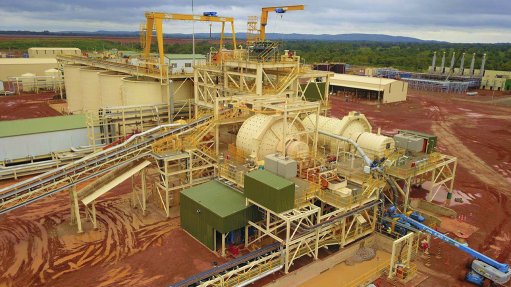
Name: Wahgnion mine.
Location: The mine is located in Léraba province, in south-western Burkina Faso.
Mine Owner/s: Terranga Gold (90%) and Burkina Faso government (10% free carried interest).
Brief Description: The Wahgnion mining operation is divided into four main regions, Nogbele, Fourkoura, Stinger, and Samavogo. The operation encompasses openpit mining of multiple pits of variable size over an estimated 13-year mine life.
Brief History: Much of the current Wahgnion mine area was held by Western Mining Corporation (WMC) from 1996 to 1999.
First-pass wide-spaced vertical rotary air blast (RAB) drilling by WMC encountered significant mineralisation at the Nogbele and Fourkoura deposits. Resolute (West Africa) and Sanembaore held the property from 1999 to 2005 and completed geological mapping, soil sampling, RAB, and reverse circulation (RC) drilling, as well as geological mapping and rock chip sampling.
Sanembaore went into a joint venture with Gryphon Minerals over the property from 2005 to 2007.
In 2007, Gryphon acquired Sanembaore’s interest in the property and initiated a comprehensive exploration programme comprising geological mapping at various scales, remote sensing, soil and stream sediment sampling, trenching, airborne geophysical surveying, ground geophysical surveying and auger, air core, as well as RAB, RC, and diamond drilling on several targets.
From 2011 to 2015, Gryphon completed mineral resource estimates and resource updates on the Nogbele, Fourkoura and Samavogo zones.
In 2013, Gryphon completed a feasibility study based on an openpit mining scenario and a two-million-tonne a year carbon-in-leach processing plant. An updated feasibility study examining the potential for reduced capital through the construction of a two-million-tonne-a-year heap-leach processing option was completed in 2014.
On October 12, 2016, Teranga Gold completed its acquisition of Gryphon.
The mine had its first gold pour in August 2019 and achieved commercial production in November 2019.
Primary Metals: Gold.
Secondary Metals: None stated.
Geology/Mineralisation: The property is located in the south-west corner of Burkina Faso within the Paleoproterozoic Birimian Senoufo belt. The Senoufo belt trends north‐north-east and comprises mainly basaltic and andesitic volcanic rocks, lesser sedimentary rocks and numerous gabbroic to granitic subvolcanic plutons.
Mineralisation at the property is structurally controlled and is widely associated with hematite, iron carbonate, sericite, pyrite and, locally, with albitic alteration. Higher gold grades are commonly associated with stylolitic laminated quartz veins or pyrite veinlets. Coarse-grained gold is found in fractures within pyrite veins or in quartz‐carbonate vein selvages. Mineralisation is predominantly of a lode‐style gold type, associated with discrete structures. The mineralisation is interpreted to have formed from the same mineralising system, with variations in style reflecting the difference in local lithological and structural settings.
Reserves: Total proven and probable openpit reserves as at May 31, 2018, were estimated at 31.07-million tonnes grading 1.62 g/t gold.
Resources: Total measured and indicated resources as at May 31, 2018, were estimated at 50.5-million tonnes grading 1.51 g/t gold. Inferred resources were estimated at 5.25-million tonnes grading 1.41 g/t gold.
Mining Method: Conventional openpit mining, using drill-and-blast with material movement by hydraulic excavators and trucks.
Major Infrastructure and Equipment: Existing infrastructure includes an exploration camp located near the village of Niankorodougou (also known as Nianka). The exploration camp includes a cafeteria, an office, a core logging facility and a sample preparation facility.
The process plant design is based on a conventional carbon-in-leach (CIL) gold process flowsheet consisting of primary crushing, semiautogenous grinding and ball milling, with a pebble crusher, CIL gold extraction, elution, electrowinning, and gold smelting to produce doré on site. Throughput is designed to range between 2.2-million tonnes a year and 2.5-million tonnes a year, depending on the blend of soft and hard ore.
Tailings will be stored in a conventional paddock-style tailings storage facility, located east of the processing plant.
The owner-operated mining fleet comprises 500 hp backhoe excavators, 50 t payload rigid frame haul trucks, and various support and ancillary equipment.
Prospects: With the mining operation reaching commercial production, Terranga has now turned its attention to conducting a reserve development programme focused on optimising the mine plan and adding reserves to extend the current 13-year mine life.
Contact Details:
Teranga Gold Corporation
Tel +1 416 594 0000
Email investor@terangagold.com
Website https://www.terangagold.com